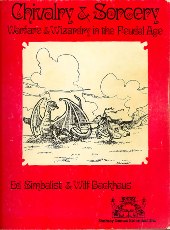Fantasy Games Unlimited published the first edition in 1977.
Reception
Two reviews of Chivalry & Sorcery appeared in Ares Magazine . In the inaugural issue of March 1980, Greg Costikyan gave the game an average score of 6 out of 9, saying, "Although the lack of world-design rules and poor organization are sorely felt, C&S remains the best full-scale complicated FRP game published to date." [4] In the magazine's September 1980 edition (Issue #4), Eric Goldberg liked the well-researched information on the medieval period — particularly heraldry — presented in the rules, but bemoaned the complexity, saying, "The worst problem arises when the game is actually played — it can move as awkwardly as an octopus on dry land." Goldberg called the production values primitive — "The text consists of reduced reproductions of typewritten pages, and the illustrations are fair to mediocre." He also found the extensive rules extremely disorganized. Although Goldberg admitted that "No FRP system has since matched the quantity and quality of its technical system design", he did not recommend the game: "C&S is a poor game for all but the serious devotee of fantasy. It is a worthy purchase for he who wishes a reference work from which to authenticate FRP rules; it is a terrible investment for he who wishes one FRP system upon which to base a campaign." [5]
In the October 1981 edition of The Space Gamer (Issue No. 44), Jon Tindel agreed that the rules were complex and extensive, but thought that the investment of time to learn them was worth it: "It has been said that C&S is unplayable, that it is better as a work of reference, but that is emphatically untrue. I know many people who play C&S and enjoy the game very much [...] It all comes down to one question: are you willing to spend the time to learn the complicated rules? If you are, by all means buy C&S; your reward will be many hours of joy. If you are not, stay away, it is not for you." [6]
In the 1980 book The Complete Book of Wargames , game designer Jon Freeman thought that the game was too complex to be played, and added "Even if the question of complexity were disregarded, it's not suited for dungeon adventures of the conventional sort, and indeed the monsters and most of the fantasy material are included almost as an afterthought." He also thought the magic systems, although "interesting, well researched and fairly 'realistic', [are] wildly unsuited to normal adventuring." Freeman concluded by suggesting that the game was more suitable as reference material for another role-playing game, and gave it an Overall Evaluation of "Poor as a game; Excellent as a source." [7]
In his 1990 book The Complete Guide to Role-Playing Games , game critic Rick Swan found the overly detailed game overwhelming for most players, calling it "among the most complex RPGs ever published." Swan found the magic system especially complicated and pointed out that the rules themselves warned players "to think twice before choosing mages as characters. It's a warning worth taking seriously: the C&S magic system involves a mind-numbing collection of tables, formulas, and rules that could serve as a grad school text in wizardry." Swan commented that "The rest of the game is equally tough, and the skimpy examples of play, poor organization, and confusing charts don't help." Swan concluded by giving the game a rating of 2.5 out of 4, saying, "For players with insatiable appetites for detail, there are few better choices than Chivalry & Sorcery. The less obsessive will find C&S more valuable as a source of ideas." [8]
In a retrospective review of Chivalry & Sorcery in Black Gate , James Maliszewski said "Fond as I am of C&S, there's little question in my mind that those tools were often hard to use and cumbersome. Despite that, at least in the circles in which I moved, C&S was very influential. I didn’t know anyone who actually played the game itself, but the ideas Backhaus and Simbalist advanced through it held a lot of power." [9]
In his 2023 book Monsters, Aliens, and Holes in the Ground, RPG historian Stu Horvath noted, "There is a beauty in complex rules, and Chivalry & Sorcery's vividly imply a world in a way that few other RPGs, then or now, manage ... All of this detail encouraged a new kind of focus on roleplaying, certainly, but one that is bogged down by the weight of its rules and their insistence on intricately simulating the world." [10]
